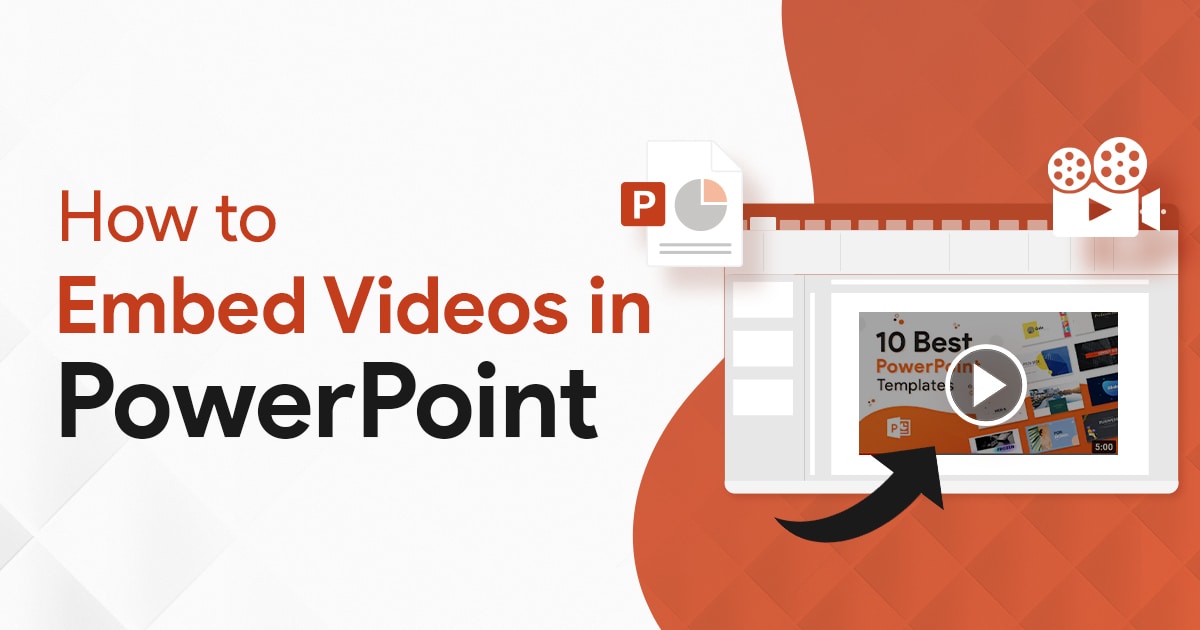How to Convert PowerPoint to Video

If you’ve ever felt the need to convert your PowerPoint presentation to a video, this article will help you. Even though it’s not a common practice, many presenters have had to export their presentations as a video, for many reasons. If you’re supposed to do the same one day, it pays to know how to convert PowerPoint to video. You can make a recording of the presentation so that it can be viewed by anyone who missed your live presentation, or for any future use. When you record the presentation, everything like your narration, the slide animations, and more get saved as a video.
But why convert PPT to video? We can give you some excellent reasons:
Reasons to convert PPT to video
- You can keep your presentation exactly the way it was intended; you can even include your animations and transitions.
- Nobody can edit your presentation.
- You can control the multimedia file size and video quality.
- Those without PowerPoint on their computers can view your presentation.
- Embedded videos in the presentation will play correctly without human intervention.
- Videos are more accessible and easier to share and can be viewed on mobile devices as ..well. You can also share them on multiple platforms – social media networks, video sharing sites, your company website, and so on.
- Most people love watching videos and prefer them over reading huge chunks of text. Human beings enjoy stories as they connect emotionally, and videos are a great way to tell stories effectively. It’s easier to convince people with videos!
So how do you convert PPT to video? Let’s see how you can do that in this article:
How to convert a PPT to Video – Method 1
Converting your PowerPoint presentation to a video may sound complex but it’s surprisingly easy. It can be done even by those who are not very tech-savvy. There are two main formats to do it. MPEG4 or MP4 is the most popular and commonly used format.
The MP4 file format is pre-compressed, and hence the videos are compact, and they can be played on almost all devices.
Converting PowerPoint to MP4
All you need to do is:
- Click on the File tab
- Click on Export
- Click on Create Video
- Select Video Quality of your choice
- Select Use Recorded Timings and Narrations (optional, use this only if you have timings and narrations set)
- Change the Seconds spent on each slide (optional)
- Click on Create Video
- Select a location on your computer
- Select Save
Now your PowerPoint presentation has been converted into a video, with the recorded timings and narrations as selected by you, or the pre-set timings you configured for each slide.
Video quality of the exported presentation
Video quality regulates the quality of the output as well as the file size. The options available are:
- 4k Ultra HD
- 1080p Full HD
- 720p HD
- 480p Standard.
1080p or Full HD is the preferred choice in most cases. However, if you’re using a huge overhead projector, and file size doesn’t matter, you can use the 4k Ultra HD format to ensure the best quality for your video. To display your videos on smaller screens, you can use the 720p or 480p formats and save space as these files will be smaller.
For mobile devices, the preferred option is the standard 480p quality; websites and social media platforms support the HD 720 p format.
Note: You need Windows 10 or newer versions to convert the PowerPoint presentation into 4K quality.
You can check the status bar at the bottom of the screen to monitor the progress of the conversion. It can take a couple of hours, especially if your presentation is long and complex. If your presentation is a long one, it might be a good idea to set it up for overnight conversion so that you don’t lose time.
Recorded Timings and Narrations options for converting PowerPoint to video
Recorded timings and narrations indicate the length of your video as well as at what time specific things happen in the presentation. You can:
- Set the number of seconds needed per slide automatically
- Click through the presentation and set rehearsal timings of your choice
- Allow the software to set the slide timings automatically by narrating the PPT with voice and video
You can also click on ‘Record Slide Show’ for the narration of your presentation, and then click on ‘Save As’ (dialog box). This will save your PPT as a video, with your narrations handling everything in the video.
Using PowerPoint animations
When you want to use animated sequences with pre-determined timing for each slide, it’s a good idea to use the ‘After Previous’ setting for every animation. This helps you to avoid lag time waiting for each animation to initiate in the video that you have converted.
Choose the animation and open the ‘Start’ option in the Animations tab, to change at what time a specific animation plays in the PowerPoint presentation.
If you want animations to be automatically initiated as the next slide plays, you need to:
- Choose the animated element
- Click on “Animations”
- Click on “Start”
- From the drop-down menu, select “After Previous”
This way, you can make sure that your animations will be initiated after moving on to the next slide or animation, whatever the previous action is.
By selecting ‘On Click’ to set your animations, it can add up to 10 seconds of delay to your video; this is because the slides will not advance automatically, but only when you click.
How to convert PowerPoint to Video – Method 2
There’s a really quick way to convert your PPT presentations into video, and that is to just use the ‘Save As’ dialog box. If you use the Record Slide Show for the presentation narration and are fine with the 1080p full HD video quality, this option works well. When you use the Record Slide Show option, all the elements you choose, like animations, actions, slide timings, etc. are saved inside the narration; so, PowerPoint will simply save itself as a video by using the pre-selected settings.
Here is a detailed guide:
- Click on F12, or press Ctrl + Shift + S; this opens the ‘Save As’ dialog box
- Select where you want to save the video
- Select MPEG4 or WMV format
- Select Save
It must be noted that though you have the option to save in WMV, it is preferable to save as MPEG4 as it has universal acceptance. The actual saving process could take a couple of minutes, and maybe more if your presentation is a long one.
When it’s done, your PPT will be saved in the 1090p Full HD video format. In case you need to save it in a different video quality, refer to the steps mentioned in Method 1, where you have to use the ‘Create a Video’ dialog box.
How to Convert PowerPoint to Video on Mac
If you have PowerPoint 2019 for Mac, PowerPoint for Microsoft 365 for Mac, or later versions of the software, you can follow these steps to convert PowerPoint to Video on Mac:
- Select the File tab, and then click on Export
- Select the video format, MP4 or MOV, in the File Format menu
- Select preferred video quality – Low, Internet, or Presentation
- Check the ‘Use Recorded Timings and Narrations’ box if you have them and want to include them in the video
- Select the timing for each slide in the video in case you don’t have a set timing
- Click on Export
Points to Remember:
- Audio narration is included in the video in versions of PowerPoint for Mac from 16.19 onwards
- Apart from narrated audio, embedded media files in your converted video will not play
- To send your presentation to someone who doesn’t have PowerPoint for Mac, you need to export it as a PDF file or picture format.
Recording and Setting Timings for Your Video
When you convert your presentation into a video, the timings determine the video length as well as when your animated sequences are initiated. If you have multiple animated sequences, you won’t be able to control the delay between them and your content. Here you need to use the Rehearse Timings feature. This can be done in four ways:
1. Fix the number of seconds per slide: in the Export to Video box, select how many seconds each slide should play in your video. Obviously, the more seconds you select per slide, the longer your video will be.
- Open the File Tab
- Select Export
- Click on Create Video
- Select the number of seconds
- Select Create video
2. Define transition timings to move the slides: transitions help to smoothen the slides changing as well as automatically advance them. In the Transitions tab, you can configure a set number of seconds for every slide and adjust the time spent on each slide. Here’s how you do it:
- Go to ‘Transitions’ tab
- Select a transition
- Choose an effect
- Select the duration for the slide
- Select Apply to All
Assuming you selected the Uncover transition and set 4 seconds, all your slides will have the Uncover transition and auto-advance after 4 seconds. The duration of transition between slides can also be adjusted, though the default duration of 2 seconds is a good option too.
3. Using the Rehearse Timings command: this can be used to control the timing flow and by manually clicking through your presentation.
- Go to Slide Show
- Select Rehearse Timings
- Use the dialog box and click through the PPT
- After finishing, select Yes to save the timings
When you click Repeat, the rehearsal timing is started over for the slide you are currently on; this allows you to restart the timing without restarting the presentation.
4. Using the Record Slide Show command: This is the latest method for adding both audio and video narrations to your PPTs. When you use this tool, all your slide elements get recorded for every slide. You can easily convert your narrated PPT presentation into a video with the help of the ‘Save As’ dialog box.
- Go to Slide Show
- Open the Record Slide drop-down menu
- Choose Record from Beginning
Remember that if you don’t open the drop-down menu and select Record Slide Show, the narration will be recorded from the slide you are currently on.
What Parts of a Presentation Won’t Be Included in the Video?
When you convert your PowerPoint presentation into a video, the following elements will not be included:
- Media that was inserted in earlier PowerPoint versions. If you need them, you have to either upgrade or convert the media. If you don’t do that, the media will play in the presentation itself, but the link will be eliminated when you convert the file and export it in video format. To upgrade the media, you can right-click on it, and select upgrade. The object will get upgraded, and embedded in the file, and it will be exported properly. The other option is to convert the file to the new format by simply going to the File tab, and selecting Convert under Info.
- QuickTime media. This can be included only if you have installed ffdShow – an optimized, compatible third-party QuickTime codec.
- OLE/ActiveX controls
- Macros
What Can You do With Your Converted Video?
Once you convert your PowerPoint presentation into a video, you can share your video in several ways:
- You can email the presentation to people who can view it on their mobile devices or computers. They can watch the video at their leisure.
- You can save it to a file share or any such location you choose.
- The converted video can also be embedded in another presentation. Of course, how to do that, is another topic for another day!
- The video can be shared on your organization’s website, blog site, and social media pages.
- You can also upload it to your company’s Microsoft Stream video sharing site.
Conclusion
There you have it! Wasn’t this easy? Let’s quickly recap:
- You can use the Create a Video feature to export your presentation as a video.
- You can use the Save As dialog box to save your PPT presentation as a video.
- By using the Record Slide Show feature, you can narrate your presentation, and use the Save As box to quickly convert your presentation into a video.
You have two options of file formats in PowerPoint. However, we strongly recommend using the MP4 file format as it has universal acceptance, and is easily accessible. It can be played on almost any device that is commonly used.


